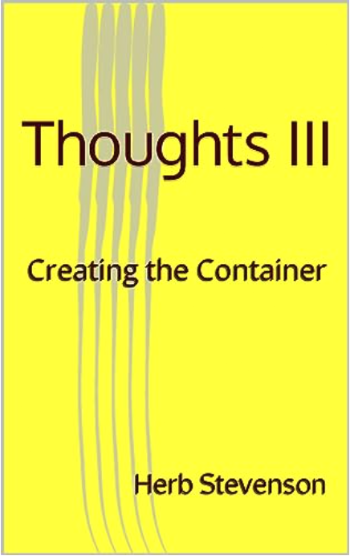

A book by Herb Stevenson, Volume 1. Learn more on Amazon.
Thoughts II:
The Next Step: A Calling

Volume 2 of 3. Learn more on Amazon.
Thoughts III:
Creating The Container

Volume 3 of 3. Learn more on Amazon.
To Lead
Read the article about training with Herb Stevenson in ALN Magazine.
See the article...
Kotter’s Sense of Urgency
by Herb Stevenson
Establishing a Sense of Urgency by examining market and competitive realities and identifying and discuss ing crises, potential crises, or major opportunities
Complacency: A common pitfall for many successful organizations is the rise of complacency. Complacency attempts to ride the good feeling of having succeeded during highly competitive or any type of crisis that potentially threatens the existence of the organization. Examples are economic downturns, such as that in 2008-9, where many organizations failed due to lack of immediate action caused by the inability to believe and act in a worst case scenario, or an explosion within a manufacturing plant that creates havoc in production as well as potential well-being of factory workers. Complacency, typically, follows after successfully navigating through one of these events and a collective sigh of relief gains momentum via stories of "having dodged the fatal bullet". The bottomline is that complacency results from believing that the organization is on the leading edge of success without ensuring that it is. New initiatives do not take root easily, competition is not studied for new inroads that could undermine or redefine the market, such as disruptive innovations, and market changes are not examined for new approaches to capture the changes rather than believe that sequential adjustments will solve whatever problems exist. Interestingly, the resistance to change rises over time as the organization creates a false sense of infallibility.
Sources of Complacency
- The absence of a major and visible crisis, especially for adrenal driven organizations.
- Too many visible resources without clarity of the validity and continuation of such resources.
- Low overall performance standards, often in organizations that have fallen asleep with the same people in leadership positions for more than a decade with little turnover.
- Organizational structures that focus employees on narrow functional goals, with little involvement and clarity on the larger, more strategic picture.
- Internal measurement systems that focus on the wrong performance indexes, often, the result of not ensuring alignment over time with the changing market, competition, and internal organization.
- A lack of sufficient performance feedback from external sources, such as not really listening to customer complaints to realize that the products do not meet the needs of the client.
- A kill-the-messenger-of-bad-news, low candor, low confrontation culture, often, found in family owned businesses where influence does not go both ways.
- Human nature, with its capacity for denial, especially if people are already busy or stressed. New executives often fall prey to this issue as the capacity to step into the position has not been fully developed and overwhelm shades their perspective.
- Too much happy talk from senior management, where the bias is towards the positive, when the reality of all business is to successfully balance all views towards the greatest success.
False Urgency: Over the last two decades, one approach to overcome complacency has been to create a false sense of urgency. It is driven by pressures to perform that actually create fear, anxiety, and anger. Because it is a false sense of urgency, often created through veiled threats, the resulting frantic activity is more distracting than useful. Unproductive noise is created that wastes time, energy, and brainpower. Often, the response is to look busy instead of to be productive. The veiled threat is neutralized with a veiled action.
In times of any real threat to the organization, such as disruptive innovations to the market which create not only replacement products, but new markets, new price structures, and a realignment of the market, false urgency misdirects the resources of the organization to more veiled action and no capacity to meet the crisis head on. Many of the recently failed organizations were directly the result of "veiled action" in respond to real threat.
A noteworthy aspect of false sense of urgency is that the organization might be highly skilled at responding to economic crisis while functioning under a false sense of urgency to market, product, or competition threats. Hence, within an economic recession, the organization might act with such deftness to startle one's sense of amazement, while laggardly and awkwardly responding to all other threats.
Sources of False Urgency
- Frenetic activity directly resulting from veiled threat, such as unrealistic performance standards and/or reward standards.
- Power-point presentations supersede clearly directed and aligned actions throughout the organization, with more criticality if at the top.
- Meetings to address all issues, including follow-up, when periodic phone calls, one-on-one updates can be used to shape and refine what is desired and realistic in the organization.
- Projects tend to geometrically grow without clearly integrating them into alignment with the organization's vision and mission.
- Overwhelm and/or apathy is a common response to new goals or duties or challenges as the whole is not adequately factored into the discussion to ensure integration and alignment with the larger organization.
- Stress levels run high as evidenced by bursts of frustration or anger and rising health concerns within the organization. Passive aggressive behavior is common.
- Internal focus on work to be done, with a leaning towards believing one is always being pushed to the limit in each moment.
Real Sense of Urgency: A real sense of urgency motivates people to relentlessly look for ways to enhance and integrate their way of being and doing within the organization. Work that adds little value to the organization is shed rather than allow it to clog the calendars and slow down needed action. It is highly positive and highly focused energy that supports the engagement of every employee to move and win, now. There is a constant viewing of what's happening outside the organization and overlaying it with what is happening within the organization to ensure that any changes do not materialize into bonafide threats. There is a clear connection throughout the organization between the head and the heart. There is agreement about the future and why the organization should not only survive any threat, but should thrive. Hence, there is an internally driven compulsion that nurtures each employee to strive to greater heights.
To increase the real sense of urgency, the organization needs to create a strategy that creates action that is exceptionally alert, externally oriented, relentlessly aimed at winning, making some progress each and every day, and constantly purging low-value added activities-- by always focusing on what provides heart and meaning to the organization.
Some tactics to consider
- Bring the outside into the organization by clearly reconnecting internal reality with external opportunities and hazards and ensuring that compelling data, people, video, sites, and sounds are part and parcel of the organization.
- Behave with urgency and passion every day by never acting content, anxious, or angry and demonstrate your own sense of urgency in meetings, one-on-one interactions, memos, and email to as many people as possible.
- Find opportunity in crisis by always being alert to see if the crisis can be an ally and not just a dreadful enemy, often hidden is complacency, while acknowledging that any crisis can be deadly and therefore should never be approached without respect.
- Deal with the No-No birds that do everything in their power to kill change and any sense of urgency. Remove or neutralize the relentless urgency-killers, people who are not skeptics but are determined to keep group complacency or that create false and destructive urgency.
Sources for Creating A Real Sense of Urgency
- Create a crisis allowing a financial loss, exposing management to major weaknesses vis-a-vis competitors, or allowing errors to blow-up instead of being corrected at the last minute.
- Eliminate obvious examples of excess.
- Set revenue, income, productivity, customer satisfaction, and cycle time targets so high that they cannot be reached by conducting business as usual.
- Stop measuring subunit performance based only on narrow functional goals. Insist that more people be held accountable for broader measures of business performance.
- Send more data about customer satisfaction and financial performance to more employees, especially information that demonstrates weaknesses vis-a-vis the competition.
- Insist that people talk regularly to unsatisfied customers, unhappy suppliers, and disgruntled shareholders.
- Use consultants and other means to force relevant data and honest discussion into management meetings.
- Put more honest discussions of the firm's problems in company newsletters and senior management speeches. Stop senior management happy talk.
- Bombard people with information on future opportunities, on the wonderful rewards for capitalizing on those opportunities, and on the organization's current inability to pursue those opportunities.
We Appreciate Your Feedback
Please let us know if you found this article interesting or useful. We will not submit this information to any third parties.

